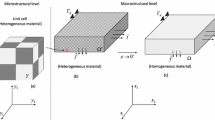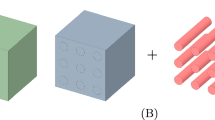Abstract
This paper demonstrates that it is possible to calculate the complete set of elastic mechanical properties for graphite-epoxy fiber-reinforced materials at any fiber-volume fraction by modifying equations previously developed to include transversely isotropic graphite-fiber properties. Experimental verification of the modified equations is demonstrated by using these equations to curve fit elastic-property data obtained ultrasonically over a range of fiber-volume fractions. Material systems under consideration are T300/5208, AS-3501 and Modomor II/LY558 graphite epoxy. Using the modified equations it is possible to extrapolate for fiber properties. From Modomor II/LY558 ultrasonic data, it is shown that five out of seven extrapolated graphite-fiber properties are consistent with the assumption that graphite fibers are transversely isotropic. Elastic properties for T300/5208 and AS-3501 are ultrasonically evaluated by propagating stress waves through six individual specimens but at various angles from a block of unidirectional material. Particular attention is devoted to specimen dimensions. To demonstrate the need for accurately calculating or experimentally measuring all lamina elastic properties, a brief discussion is included on the effect that variations in lamina elastic properties have on calculating interlaminar stresses.
Similar content being viewed by others
Abbreviations
- A :
-
unidirectional block dimensions, m
- C ij :
-
material stiffnesses, contracted notation (i,j=1,2,3,4,5,6), Pa
- c i :
-
wave-phase speeds (i=1,2,3), m/s
- D :
-
transducer diameter, m
- E i :
-
Young's moduli along lamina coordinates (i=1,2,3), Pa
- E b :
-
matrix Young's modulus, Pa
- E f L :
-
fiber longitudinal Young's modulus, Pa
- E f T :
-
fiber Young's modulus in the transverse plane, Pa
- G ij :
-
shear moduli in the laminai-j plane (i,j=1,2,3), Pa
- G b :
-
matrix shear modulus, Pa
- G f LT :
-
fiber shear modulus in the longitudinal-transverse plane, Pa
- G f TT :
-
fiber shear modulus in the transverse plane, Pa
- K b :
-
matrix plane-strain bulk modulus, Pa
- K f TT :
-
fiber plane-strain bulk modulus, Pa
- L :
-
specimen length, m
- M :
-
margin, m
- QL :
-
quasi-longitudinal wave
- QT :
-
quasi-transverse wave
- S :
-
time separatingQL andQT waves, s
- T max :
-
specimen thickness necessary to separateQL andQT waves, m
- T min :
-
specimen thickness satisfying energy-flux requirements, m
- b :
-
matrix-volume fraction
- V f :
-
fiber-volume fraction
- W :
-
transmitted pulse width, s
- θ:
-
angular deviation of energy flow from the wave normal, deg
- ν b :
-
matrix Poisson's ratio
- ν f LT :
-
fiber Poisson's ratio in the longitudinal-transverse plane
- ν f TT :
-
fiber Poisson's ratio in the transverse plane
- ϱ:
-
lamina mass density, kg/m3 (N-sec2/m4)
References
Pipes, R.B. andPagano, N.J., “Interlaminar Stresses in Composite Laminates Under Uniform Axial Extension,”J. of Comp. Mats.,4,204 (1970).
Rybicki, E.F. and Schmueser, D.W., “Three Dimensional Finite Element Stress Analysis of Laminated Plates Containing a Circular Hole,” AFML-TR-76-92 (Aug. 1976).
Hsu, P.W. and Herakovich, C.T., “A Perturbation Solution for Interlaminar Stresses in Composite Laminates,” Composite Materials Testing and Design (Fourth Conference), ASTM STP 617, 296 (1977).
Hashin, Z., “Theory of Fiber Reinforced Materials,” NASA-CR-1974 (Mar. 1972).
Whitney, J.M., “Elastic Moduli of Unidirectional Composites with Anisotropic Filaments,”J. of Comp. Mats.,1,188 (1967).
Dean, G.D. and Turner, P., “The Elastic Properties of Carbon Fibers and Their Composites,” Composites (Jul. 1973).
Kriz, R.D. and Stinchcomb, W.W., “Mechanical Properties for Thick Fiber Reinforced Composite Materials Having Transversely Isotropic Fibers,” VPI-E-77-13 (May 1977).
Hofer, Jr., K.E., Larsen, D. and Humphreys, V.E., “Development of Engineering Data on the Mechanical and Physical Properties of Advanced Composite Materials,” NTIS #AD-A014 363 (Feb. 1975).
Kriz, R.D., “Effect of Material Properties on Interlaminar Stresses in Angle-Ply Composite Laminates,”VPI-E-77-16, Virginia Polytechnic Institute and State University, Blacksburg, VA (1977).
Author information
Authors and Affiliations
Rights and permissions
About this article
Cite this article
Kriz, R.D., Stinchcomb, W.W. Elastic moduli of transversely isotropic graphite fibers and their composites. Experimental Mechanics 19, 41–49 (1979). https://doi.org/10.1007/BF02324524
Received:
Revised:
Issue Date:
DOI: https://doi.org/10.1007/BF02324524




